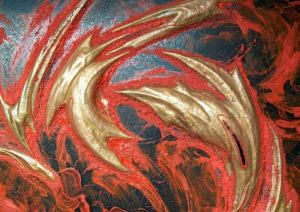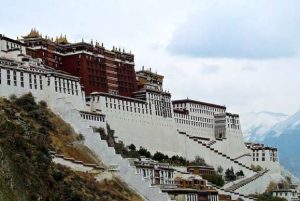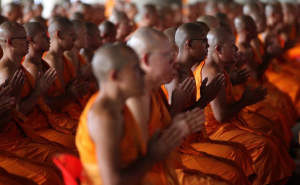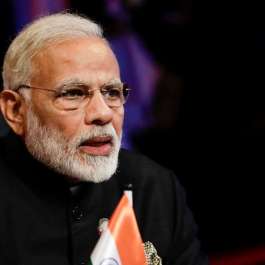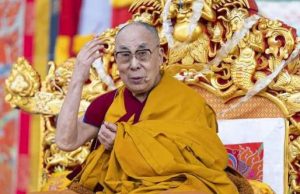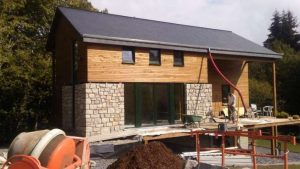
The Jogye Order of Korean Buddhism, South Korea’s largest Buddhist order, has announced plans to restore a 1,300-year-old rock-carved statue of the Buddha that is believed to have been toppled in an earthquake some 600 years ago.
The five-meter, 80-tonne stone sculpture, discovered in 2007 by the Gyeongju National Research Institute of Cultural Heritage, is located near Yeolamgok Buddhist temple on Namsan Mountain near the city of Gyeongju, in South Korea’s North Gyeongsang Province. The statue was found lying face-down, its nose just five centimeters from a rock face, but with its features otherwise undamaged.
“The Buddha [statue has] spent a thousand years lying face down, to bear the sufferings of the people,” Venerable Jinwoo, president of the Jogye Order, said during a press conference in Seoul on 11 January. “Erecting the Buddha means raising up ourselves, and this will become a holy Buddhist service that restores the nature in all of us.” (The Korea Herald)
The Jogye Order is a school of Seon (Zen) Buddhism that traces its roots back 1,200 years to the Unified Silla (also known as the Later Silla) kingdom (668–935). The Jogye school as a distinct entity emerged in the late 11th century when the monk Bojo Jinul, credited as the school’s founder, sought to combine Seon practices with the theological underpinnings of sutra-based Buddhist schools, including Korean Pure Land Buddhism. The order now represents the largest segment of South Korea’s Buddhist population, administering about 1,900 active temples, more than 13,000 monastics, and seven million lay followers nationwide.

Studies on how to salvage the Buddha statue are underway and are expected to be concluded by midyear. Planning includes where the statue will eventually be relocated once it is safely upright. The restoration plan is being drawn up by the Cultural Heritage Administration and the city government of Gyeongju, with completion expected by 2025.
Researchers believe that the granite statue, which has been dated to around the late eighth Century, during the Unified Silla period, was toppled when a 6.4-magnitude earthquake struck the region in 1430. A senior researcher from the Cultural Heritage Administration explained that the rescue plan required painstaking attention to detail as the statue is currently resting on a precarious 45-degree incline.
“Minor cracks have been found in the Buddha statue, and there is no precedent for moving a relic that weighs over 80 metric tonnes,” the official noted, adding that a simulation of the rescue attempt using a life-sized replica of the statue would be conducted next year. (The Korea Herald)
“Gyeongju and Pohang had earthquakes in 2016 and 2017, respectively, and there were bigger earthquakes in the past,” the official explained. “When re-erecting the statue, we have to make sure that the statue is set up in a spot that is safe against natural disasters.” (The Korea Herald)
The project to restore the fallen statue has been a point of discussion since its discovery in 2007. Speaking in 2020, Ven. Ilgam of the Jogye Order observed: “It has been 600 years since the Buddha statue of Yeolamgok Valley fell onto the ground, yet the [statue] emerged in this time period without any damage. When we think about why it happened, we may be given a historical mission to raise the Buddha to [restore] Korean Buddhism.” (Jogye Order of Korean Buddhism)
According to data from the 2015 national census, the majority of South Korea’s population—56.1 per cent—holds no religious affiliation. Christians make up the largest religious segment of the population at 27.6 per cent, while Buddhists account for 15.5 per cent.
See more
Fallen ancient Buddha statue to be put upright by 2025 (The Korea Herald)
Stone Buddha Statue at Yeolamgok Temple Site, Namsan of Gyeongju (Korean Journal of Art History)
[One Million Vows Assembly] 2. Raising Buddha Properly in Mt. Namsan, Gyeongju City (Jogye Order of Korean Buddhism)
Buddha at Yeolamgok Valley (HISTORYLIBRARY 역사문화라이브러리)
Related news reports from BDG
Ancient Korean Buddhist Text to Be Inscribed on UNESCO Memory of the World Register
South Korea President Meets with Buddhist and Other Religious Leaders in Wake of Itaewon Tragedy
Buddhist Leaders Join Memorial for Victims of Deadly Halloween Tragedy in Seoul
Engaged Buddhism: 20th Biennial INEB Conference Concludes in South Korea with a Commitment to Action, Peace, and Change
New Head of Jogye Order of Korean Buddhism Takes Office
Seoul International Buddhism Expo to Focus on Ritual




